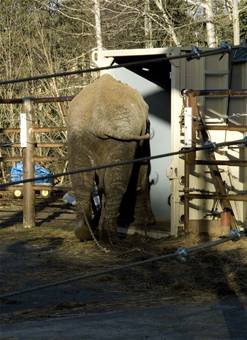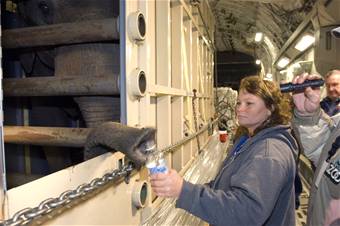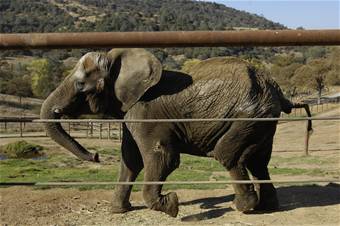 by Staff Sgt. Francesca Popp November 06, 2007
Maggie, the Alaska Zoo's only elephant, arrived at the Performing Animals Welfare Society's ARK 2000 Wildlife Sanctuary Nov. 2, exiting her crate some 15 hours after leaving Elmendorf Air Force Base. Air Force officials agreed to assist in moving the 25-year-old, 8,000-pound pachyderm, since no commercial airlift was available.
"We contacted local authorities in Anchorage and began the lengthy process of requesting an Air Force flight for Maggie," said Pat Derby, PAWS co-founder and president, who agreed to reimburse the Air Force. "After several weeks of negotiating, we secured permission from the Air Force to fly Maggie for a price -- between $215,000 and $300,000." All the while, the logistics for the move were being planned. It took several agencies in the Air Force, as well as officials from the Alaska Zoo and PAWS, to ensure the 8,000-pound African elephant would be safely relocated from the Alaska to California. "She may not have been able to get out ( of Alaska ) at all if it wasn't for the Air Force," said Ed Stewart, PAWS co-founder and director. "It wasn't just doing it, but the way they did it. They were so thoughtful of her. They made sure they didn't rattle the chains when binding her down. The climb out of Elmendorf was a certain pitch so as not to tip Maggie and it was probably a good training mission for sensitive cargo like that. It could not have been better." A C-17 Globemaster III assigned to the 517th Airlift Squadron at Elmendorf was selected as Maggie's aerial transport. The crews tasked to fly the live cargo to Travis Air Force Base, Calif., were a mix of active-duty and Alaska Air National Guard Airmen. The pilots who planned the flight took into account the take off angle, as well as the aircraft's cruising altitude. In the end, they said Maggie was an excellent passenger. "There were no problems in flight with Maggie. She seemed comfortable the entire time," said Capt. Blake Johnson, 517th AS mission commander for Operation Maggie Migration. He added that the C-17 operated smoothly and the support at Elmendorf helped ensure a smooth flight. While the pilots were planning, so were the loadmasters. The loadmasters coordinated with the Air Transport Test Loading Activity at Wright-Patterson AFB, Ohio, to develop a load plan for Maggie. "How many elephants need to be moved from one place to another via ( military ) air? Not very many. It's a rare, exotic cargo," said Senior Master Sgt. Mark Stamm, 249th Airlift Squadron loadmaster superintendent, who was one of three loadmasters on the flight. "To prepare for the flight, I got back in the books to make sure the restraints for the elephant cage were proper, reviewed the engineering paperwork given to us for restraining the elephant. I also reviewed the loading and offloading procedures."
The crate Maggie traveled in from the zoo to the sanctuary was re-enforced and certified for airlift by Air Force Materiel Command officials before it was ever loaded on the C-17. The loadmasters, as well as members from the 732nd Air Mobility Squadron tested the plan using the 10,000-pound, 10-by-8-by-18-foot crate. "We did dry runs of loading the container to ensure it would fit and there would be no problems during loading," said Senior Master Sgt. John Brindley, 732nd AMS airlift services superintendent. "All possible precautions for the elephant and loading were taken care of ( days before the flight )." On moving day, Maggie walked out of her barn at the Alaska Zoo for the last time. She stepped into her crate with encouragement from her trainers. She was secured once fully inside the crate and then the doors shut. A crane lifted the crate and Maggie on to a flatbed truck and began the 40-minute drive across Anchorage to Elmendorf. Once on base, Maggie and the crate were weighed and transferred from the flatbed to a 60K loader. The mobile conveyor belt was decorated with a banner signed by people wishing the pachyderm well: "Remember to pack your sunglasses," "Have fun," "Hope you get a suntan," "We'll miss you," and more. The 60K loader then slowly rolled to where the C-17 was parked on the flightline. As Maggie was being pulled on the aircraft, she trumpeted twice as if to say goodbye to everyone in Alaska and thanks for the memories. The doors to the C-17 closed. She trumpeted once more just before take off as if to say "I'm ready to go." The Alaska Zoo is the only large zoo in Alaska and is one of the state's biggest attractions, drawing 200,000 visitors each year. Maggie, who was 1-year-old at the time, came to the Alaska Zoo in 1983, after much of her herd was selectively destroyed in Zimbabwe. She became a companion to Annabelle, an Asian elephant, for the next 15 years. Annabelle died in 1997. For many years, animal rights activists argued that Maggie's indoor barn and outside yard were inadequate, the Alaska climate too cold, and that her isolation from other elephants was cruel, since elephants, particularly female elephants, are social animals. The board of directors of the zoo voted to relocate Maggie in June, since it was in the best interest to her health and well-being to be with other elephants in a milder climate. Shortly after selecting PAWS as Maggie's new home in September, zoo officials contacted Air Force representatives to assist in her move. Maggie's crate arrived at the zoo in early October. Her trainers immediately began teaching Maggie how to enter the crate. They said Maggie's training was essential for the move and to keep everything positive.
"( We taught her how to stay ) calm, got her used to the leg chains and re-enforced that she did what we asked her to and ensured she understood it's all about her," said Jamie Logan, a zoo keeper and Maggie's trainer for the last eight years. While Mr. Logan and zoo officials agreed it's sad to see Maggie go, they know this move was a good opportunity. The Air Force is a huge part of the community and many people from the base visited Maggie during her time at the zoo. The flight was a training opportunity for the C-17 crew and didn't interfere with the Air Force mission. The ARK 2000 Wildlife Sanctuary is located about 85 miles east of Travis AFB. It is 2,300 acres of land with rolling hills, trees, ponds and other facilities made to replicate a natural habitat. Maggie joined four other African elephants and five Asian elephants at her new home. The elephant section of the habitat is 30 acres of varied natural terrain to roam, lakes to bathe in, and state-of-the-art elephant barns equipped with heated stalls and therapeutic pools, according to the PAWS Web site. "We were faced with a real problem. We had to get Maggie out of Alaska in the late fall," Mr. Stewart said. "It was almost impossible with the short time we had to work to get the crate up there to ensure it was tall enough for her. All the commercial cargo people have small doors on their planes and the veterinarians suggested to not cut her space down, because it would be bad for travel, she wouldn't be comfortable and might have a problem. "There are only a few planes that can move this type of cargo. I think the C-17 was absolutely up and beyond our wildest dreams," he said. Upon arrival at ARK 2000, Maggie exited her crate as soon as the last restraining bar was removed. She smelled her new surroundings and went in the barn and began exploring. Her trainers from the Alaska Zoo were by her side the entire trip. They offered her water, treats and gave her a bath inside the barn. Maggie then went outside and was greeted by her new bunkmates: Mara, 71, Lulu and Ruby. "In Maggie's case, it was just like a text book," said Mr. Stewart. "She came in the first gate and we closed it behind her. She went into three or four different stalls and then came right outside into the shoots. A lot of that is because her keepers from Alaska are with her."
Source of News & Photos:
Publish A Letter in SitNews Read Letters/Opinions
|
||||


